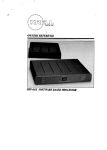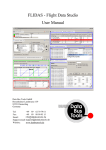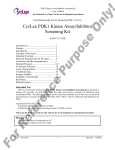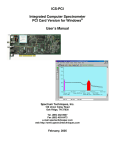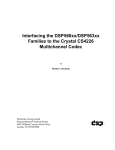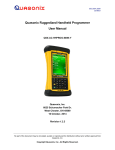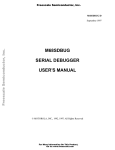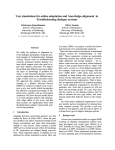Download NIM paper. - Princeton University
Transcript
Halny: a Digital Signal Processor Based Module for the Readout of Silicon Strip Detectors E. Banas, A. Bo_zek, P. Jalocha, P. Kapusta, 1 Z.Natkaniec, W. Ostrowicz, H. Palka, and M. Roz_ anska Henryk Niewodniczanski Institute of Nuclear Physics, ul.Kawiory 26A 30-055 Krakow, Poland D. Marlow Joseph Henry Laboratories, Princeton University, Princeton NJ, 08544 USA M. Tanaka High Energy Accelerator Research Organization, 1-1 Oho, Tsukuba, Ibaraki-ken, 305 Japan Abstract We describe a four-channel, digital-signal-processor-based readout board, equipped with analog-to-digital converters. A series of identical boards work in parallel in the BELLE experiment at KEK, performing a zero-suppressing readout of the silicon vertex detector. A cluster-searching algorithm executes quickly enough to allow dead time-free readout at a 500 Hz trigger rate. DSP code downloaded to the boards can be easily modied, aording a high degree of exibility. We describe the board hardware, the algorithms employed in the experiment, and the software used to implement them. 1 Introduction The Silicon Vertex Detector (SVD) of the BELLE (1) experiment at KEK consists of 81,920 channels and is foreseen to operate at trigger rates up to 1 Corresponding author. E-mail address: [email protected] Preprint submitted to Elsevier Preprint 4 May 2000 500Hz (2). Since the number of strips is large and the VA1 chips (3) used in the detector are not capable of on-chip zero suppression, an external datareduction system is necessary. Based on experience with a similar system from the DELPHI experiment (4) (5), data reduction using digital signal processors (DSP)s has been chosen. In the BELLE SVD, signals from the strips are amplied, shaped, and stored by VA1 front-end chips mounted in close proximity to the detector. The stored analog signals are routed to the HALNY modules in sequence using an onchip scanning analog multiplexer. Buering of the analog signals and various control signals is provided by a repeater system, (6) located at an intermediate point between the SVD and the electronics hut where the HALNY boards are situated. After common-mode uctuations 2 are corrected, a cluster-searching process is executed using pulse-height information together with individually calculated strip pedestals and widths. Finally, events are built in a compressed format. Compared with pipelined systems based, for example, on eld-programmable gaeld-programmable gate arrays, the use of DSPs oers the following advantages: dynamic pedestal updating; discrimination based on strip-by-strip signal-to-noise ratio; autonomous elimination of dead and noisy channels; exibility in programming; The main disadvantage of using DSPs is the long and variable processing time. This implies necessity of queuing events before passing them to DSPs. 2 Module Description 2.1 General The HALNY 3 is a single-width 6U VME module used for readout of multiplexed analog signals. It houses four independent channels, each consisting of an analog input block and a DSP-based processing unit. The analog input blocks accept dierential analog signals from the module's front panel. These Common-mode uctuations refer to coherent-noise eects that aect all strips in the same manner in a given event. 3 The word \Halny" is the Polish name for a warm wind blowing through the Tatra mountains. 2 2 signals are amplied, level-shifted and fed to ADCs. The ADC sensitivity is xed at 2 mV/count. Digitized values are passed from the ADC block to the processing unit through a rst-in-rst-out (FIFO) buer memory. This input FIFO serves to derandomize the arrival times of incoming data, allowing the system to cope with instantaneous rates that exceed its average rate-handling capability. The DSPs pass the processed data to output FIFOs where they can be read out via the VME backplane. The output FIFOs allow event processing in the DSPs and readout by the main data-acquisition (DAQ) system to proceed asynchronously. Every channel of the module incorporates the following functionality: a dierential analog input with xed amplication; a level shifter controlled by a 12-bit DAC; 10-bit ADC converter; conversion rate up to 10 MHz; an 8K-sample-deep FIFO; a Motorola DSP56302 processor running with a 66 MHz clock ; an 8K-deep16 bit output FIFO. 2.2 Module Operation With each occurrence of an external clock signal, sampled data from the ADC are written to the derandomizing input FIFO. Ten bits of pulseheight data are accompanied by externally-supplied start and stop event markers and four bits of event-tagging information. The DSP reads these data from the FIFO, carrying out the necessary processing steps (common mode correction, pedestal subtraction, noise calculation, cluster searching etc.) as it goes. Results are written to the output FIFO, where they are subsequently read via the VME bus. To speed up the VME transfers, 16-bit-wide words from the DSP are multiplexed into 32-bit words. Proper operation of the module requires the ability to block additional signals when the FIFO buers ll (a rare occurrence under normal conditions). This is accomplished by sending a BUSY signal derived from the programmable ALMOST-FULL state of the FIFOs. The BUSY signals from the HALNY modules in the system are wire ORed together and forwarded to the experiment's global trigger system. Thus a full buer anywhere in the system inhibits new triggers. Each output FIFO is accompanied by a 12-bit up-down counter, which the DSP increments when a new event has been passed to the output FIFO. A non-zero state of the counter can be recognized by reading the VME status register and readout of a full event can be performed. Upon completion of the 3 event readout the counter is decremented via a dened VME operation. Since each event consists of at least two 16-bit words, a 12-bit counter is sucient to manage the 8K-word output FIFO. The HALNY module uses the VME P1 and P2 connectors and works in A32 mode, recognizing all (user/ supervisor ; data/block) address modiers. The module's base address is xed by an 8-bit jumper (bits 31:24) and three rotary switches (bits 12:23). The base address can be selected to lie in the range: 0x00000000 - 0xFFFFF000. Data transfers occur in D32 mode. A block transfer readout mode of the output FIFOs is available. The module does not house the VME interrupter. 2.3 Analog-to-Digital Conversion Block A block diagram of a single ADC channel is shown in Fig.1. The heart of the block is an AD9200 ADC 4 Four such ADC blocks are placed on a daughter board, which is connected to the main board via three 64-pin miniature connectors. Two of these connectors are used for signals and the third is used for power lines. Four 14-mm dierential LEMO connectors are for the analog input signals. The analog signals must lie within the range ;4 V +4 V and must have a dynamic swing of less than 2 V. The dierential input signals from the receivers are converted to single-ended signals, and then amplied, level shifted, and limited in HFA1135 current feedback op-amp. The oset voltage used for level shifting comes from a DAC8043, which is 12-bit serial DAC controlled by the DSP. Limiting is necessary to avoid damaging the AD9200. The gain of the circuit is approximately unity and the ADC is set to operate with 0-2 V input range. Due to the behavior of the limiting op-amp, the linearity of the ADC block is aected near limits of its range. < V < The AD9200 ADC requires a continuous convert clock with a 50% duty cycle. It operates in a pipeline mode, with a four-clock-period latency between its input sample and the appearance of the corresponding digital information on its output. AD9200, a complete 10-Bit, 20-MSPS, 80 mW CMOS A/D Converter, Analog Devices, Inc. 4 4 Differential receiver - OPA620 Amplifier and level-shifter - HFA1135 Three-state buffers Data ADC 10 10 Control Signals Interface AD9200 Convert Clock Start of Event Stop of Event Busy Tag 4 DAC CONTROL Serial clock and data 64-pin CMC connector Enable DAC 8043 -5V +5V +12V -12V -12V/-5V voltage converter Fig. 1. Block diagram of the single ADC Block. Dashed shapes represents elements shared between dierent ADC Blocks. 2.4 Processing Unit Four identical processing units are placed on the main board. The heart of each unit is the Motorola DSP56302 digital signal processor chip. The DSP56302 was selected for the following features: large on-chip memories (20K24 bit of program memory, 14K24 bit of data memory), eliminating the need for external memory, thereby saving board space, lowering the costs, and reducing program execution times by keeping the entire program in cache memory; relatively high computational power|66 million instructions per second (MIPS); a small number of necessary external components; object-code compatibility with the DSP56000, for which relevant software 5 already existed. BUSY DERANDOMIZER -INPUT FIFO 4 AUXILIARY LOGIC Almost Full Data 10 Reset (8k x 16 fifo) 16 Counter DSP OUTPUT FIFO Port A DAC control (8k x 16 fifo) 16 MUX Reset 32 VME INTERFACE Tag Ports C , D 64-pin CMC connector Convert Clock Start of Event Stop of Event Write Almost Full Up + 12-bit counter Port B Down Not empty 3 Reset Host Port Signals 10 DSP Status Fig. 2. Block diagram of a single processing unit. Dashed shapes represent blocks shared between dierent units. Fig. 2 shows a general block diagram of the processing unit. Assertion of the START-OF-EVENT signal begins the acquisition cycle, at which point 10 bits of ADC data, 4 bits of event tag information, and 2 bits of start/stop event markers are written to the FIFO derandomizer at every active edge of the convert clock. This process continues until STOP-OF-EVENT comes. The derandomizer is implemented in a single Cypress CY7C4255 FIFO memory chip (8k18 bit words). The FIFO collects a complete event from the ADC block before passing it to the DSP. Assuming an event size of 1K sample and assuming that the trigger rate is smaller than the average processing time per event, the 8K sample depth of the FIFO is sucient to eectively eliminate dead time associated with the event processing. The STOP-OF-EVENT markers are counted by a counter inside the DSP. The state of this counter is used for triggering readout from the derandomizer. In this way, the DSP is able to acquire complete events with maximum speed, 6 without wasting processing power for polling. The ALMOST-FULL output of the input FIFO is asserted when the occupancy of the derandomizer exceeds a preprogrammed level. Before data acquisition starts, this level is programmed by the DSP (the path is not shown in the diagram) to be asserted when the FIFO has only enough space for one more event. This ensures that that no overwriting will occur, even under worst-case conditions, where the BUSY is asserted too late to block the next trigger. The CY7C4255 FIFO chip is also used for the output buer. A single VME read of the output FIFO results in two read cycles, wherein data from two samples are multiplexed into a single 32-bit-wide word. A 12-into a single 32bit-wide word. A 12-bit counter keeps track of the number of unread events stored in the output FIFO. A non-zero state of this counter is reported in the VME status register. To ensure a proper handshake between the VME and the DSP, the following rules are obeyed: the DSP increments the counter after an event has been transferred to the output FIFO; the VME decrements the counter after the event has been read out from the module; the DSP writes at least two 16-bit words for every event. Normally the DSP signicantly reduces size of processed events. Thus a relatively large number of events can be stored in the output FIFO and its role as a derandomizer between the DSP and the VME is not as critical as in the case of the input FIFO. Programs are downloaded to the DSP from the VME via host port lines. The same lines can be used for execution software interrupts, which can be used for accessing all DSP resources. 3 Algorithms The rst objective of the DSP code is to subtract the signal components that the o-line analysis does not want to see|i.e., the pedestals and the commonmode uctuations. Pedestal values must be determined on a strip-by-strip basis. This is done by computing a running average over several events of the value for each strip, taking care to remove samples that dier appreciably from the average, so as to minimize the impact of bona-de signals. Since the typical strip occupancy 7 DSP processing algorythm for the HALNY module CN CM <CN> D D-P + - chan #0 D-P-CM + D-P-CM N + - + Estimated common noise value D Value read from the channel of a silicon detector S Detector signal after subtracting unwanted components S #1 F Selection flag F #1 T1 T2 Single-strip select threshold F #0 + - + + - + - - P CM estimator + 1/N + - + P 1/N + + Double-strip select threshold Pedestal storage and tracking Noise reciprocial storage and tracking + - + + - chan. #127 CN + 1/N chan. #1 Estimated common mode value S #0 - P CM Adder + - - S #127 F #127 Multiplier P + - 1/N T1 Comparator T2 Logical OR Fig. 3. Processing ow inside the DSP. is only 1%, such eects are generally not too severe. Common-mode eects are estimated on an event-by-event basis for each group of 128 strips, which corresponds to one readout chip. The common-mode uctuation is estimated by computing the average of the pedestal-subtracted values of all of the strips in a group. One again, care is taken to remove nonpedestal hits using RMS-based cuts to identify non-pedestal values. The second objective of the algorithm is to reduce the amount of information by suppressing information from strips that do not to contain any useful information. The selection is based on the signal-to-noise ratio measured on each strip. It therefore requires that the expected noise variance on each strip be measured. The noise-level estimation is done for each strip in a continuous fashion, as was done for the pedestals, by computing the root-mean-square of the strip data after pedestal and common-mode subtraction. Once again, care is taken to remove bona de particle hits from the sample to be averaged. 8 The selection can now be done based on a predened signal-to-noise ratio threshold, which is normally set to four. To improve the selection eciency for particle signals distributed over several strips, the cut (with a threshold that is a bit higher) is also applied to the sum of signals registered on two, three and more consecutive strips. All signals and groups of signals exceeding the threshold are marked for later placement into the output record. The DSP can write output data in several formats, with or without suppression, and with optional compression applied to reduce the amount of data. The compression attempts to squeeze smaller signals as well as the strip numbers into one byte instead of two. This normally yields a compression factor of 1.2{1.5. Along with the signals, the data record contains statistical information, which can serve to provide individual detector health monitoring: the common mode and the RMS of each chip for every event and the pedestal and noise estimations for every strip. This information is sent in a round-robin fashion. In this way, by taking a sample of some 100 events, one can get a complete picture of pedestals and noise in the system. The DSP code is written in the assembler of the Motorola DSP56302A processor and takes some 2000 lines of assembler code and 1100 words when compiled and loaded into the DSP. At the nominal processor speed of 66 MHz (66 MIPS) the code reading 640 strips can analyze more than 500 events per second. For testing purposes, dedicated data formats are made to output raw ADC data or the ADC data partially or fully analyzed but without any zero suppression. 4 Programming The programming of a HALNY board is performed from two sides|the VME crate controller and DSPs on the board. As some internal HALNY resources are accessible either from the VME controller or from the DSP, the initialization of the board and steering during read-out is rather complex, requiring proper scheduling and divided control between programs in both processors. In this section, we describe the VME control programs. The initialization (see Fig. 4) of the HALNY board consists of: reseting of the analog board, reseting of the DSP, reseting of the 12-bit up-down counter, programming of the output FIFO, and downloading of a DSP program code to the DSPs. The programming of the derandomizers is done by the DSPs. Because the code in a DSP starts its execution immediately after downloading, 9 START Reset HALNY Analog Daughter Board Reset JTag Reset Disable Trigger 4 times Download code to DSP Read DSP program - s-record file Reset DSP channel Download program code to DSP through the DSP Host Port NO board status OK? STOP routine with error code YES Reset Output FIFO 4 times Reset DSP Event Counter NO board status OK? YES Set Identifier STOP Fig. 4. HALNY initialization and downloading DSPs. 10 it is very important to introduce synchronization mechanisms between the DSP program and the VME controller program. The identier word plays the role of a synchronizer: before taking action, the program in the DSP waits until the VME controller program writes a proper identier word through a DSP host port. The board is exible enough to allow the downloading of a unique program to each DSP. Each step of the initialization is controlled with regard to errors. The readout procedure (see Fig. 5) is activated whenever there is a readyto-read event in the output FIFO. When there is a ready-to-read event in the output FIFO, the contents of the 12-bit up-down counter become nonzero and a ag is set in the HALNY status register. The readout program performs a simple polling of the status register while waiting for data and initiates a readout sequence when the ags for all channels have been set. During the readout sequence, the readout program takes one complete event from each output FIFO in turn. As it reads the data it checks for proper start and stop markers, proper event length, proper checksum word, and proper tags. The checksum word was introduced to enhance the checking of events in a straightforward way. The DSP calculates a checksum and puts it as the last word in each event. The VME control program, after collecting all event words, calculates a checksum using the same algorithm used in the DSP and then checks it against the DSP-calculated value. The VME control programs use a dedicated library, where the steps described here and shown in the gures are implemented as a set of calls. The library and the test-control programs have been written in standard ANSI C, running on a SPARC CPU-7V (system SunOS 5.5). The library can be used by any program written in C or C++. 5 PERFORMANCE The stability of the board hardware under actual experimental conditions is very high. The 32 modules in the system required almost no maintenance during a year-long run of the experiment. At the presently achievable KEK-B luminosity of 1 5 1033 cm;2s;1 the BELLE detector trigger rate is below 300 Hz. Under these conditions the readout speed (200 ns/strip) and processing time (1.9 ms/event) of the board are completely adequate. Extrapolating to the maximum trigger rate of 500 Hz, we estimate a readout deadtime of less than 10%, consistent with the original specication. : The data sparsication is also satisfactory. Under the current experimental conditions, the board typically compresses data from the 81920 channels that 11 START Enable trigger in HALNY Read HALNY Status (flags from 12-bit counters) NO IF all flags are set YES Read out entire board 4 times Read one DSP channel Read complete event Perform checks of event correctness: Start Event Marker Stop Event Marker Event Length Control Checksum STOP routine with error code Event correct? Decrement 12-bit counter 4 times Check tag words in events from all DSPs bad correct NO Last event ? YES Disable trigger in HALNY STOP Fig. 5. Readout scheme. comprise the system into 12 Kbytes for hadronic events and 9 Kbytes for empty (background) events. The eective suppression ratio is around 10;2 and the hit eciency measured o-line (combined with tracking) is around 97%. 12 6 ACKNOWLEDGEMENTS This work was partially supported by the Polish State Committee for Scientic Research, grant no 2P03B 170 17 and the US-Japan Cooperation Fund. References [1] BELLE Detector Technical Design Report, The BELLE Collaboration, KEK Report 95-1, March 1995. [2] BELLE SVD Technical Design Report, BELLE SVD Group, March 1998. [3] O. Toker and S. Masciocchi, E. Nygard A. Rudge, and P. Weilhammer, Nucl. Instr. and Meth. A340 (1994) 572. [4] P. Aarnio et al., Nucl. Instr. and Meth. A303, (1991) 233. [5] N. Bingefors et al., Nucl. Instr. and Meth. A328, (1993) 447. [6] M. Tanaka et al., Nucl. Instr. and Meth., A432 (1999) 422. [7] Piotr Kapusta, HALNY Technical User's Manual, Instytut Fizyki Jadrowej, Cracow, Poland, 7 May 1998. [8] DSP 56302 24-Bit Digital Signal Processor User's Manual , Motorola Incorporated Semiconductor Products Sector, DSP Division, Austin TX 78735-8598; http://www.motoroladsp.com [9] Y. Yasu, Usage Guide of UNIX VME Library for General Purpose VME IO Device Drivers, Version 1.0 , KEK On-line Group. [10] M68SDBUG SERIAL DEBUGGER USER'S MANUAL, September 1997; http://motsps.com/mcu/documentation/devpdf/sdbug.pdf 13













